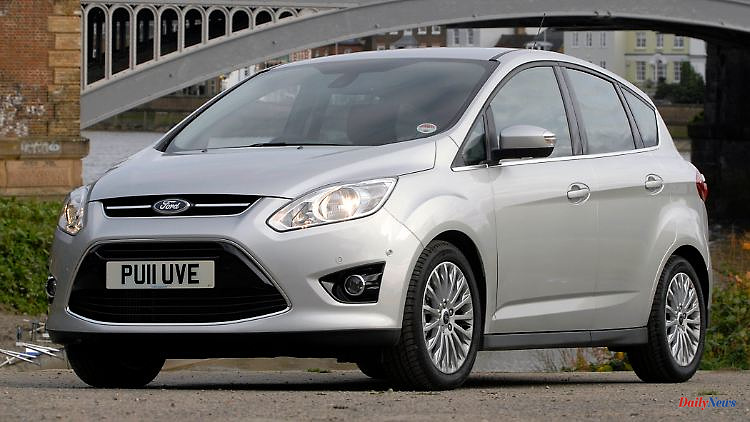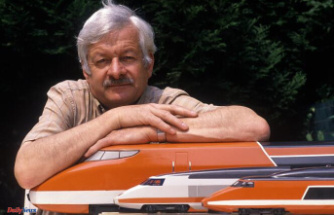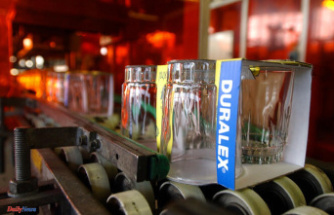If you are looking for a vehicle with space for people and hobbies, it doesn't always have to be an SUV. You will also find what you are looking for in a van like the Ford C-Max. And as a used vehicle, it basically does well in the main inspections by the TÜV - with a few weak points.
The Ford C-Max belongs to the currently unpopular category of "vans": practical, but not sexy. The C-Max offered from 2010 to 2019, which uses the Focus platform, therefore did not have a direct successor. However, for people who are looking for a lot of space for passengers or sports equipment, it could be an interesting alternative to the popular compact SUV as a used car.
body and interior
Positioned between the B- and S-Max, the C-Max is a good compromise between space and exterior dimensions that are still park-friendly. The second generation of the compact van is available in two variants: as a 4.38 meter long five-door model and as a 4.52 meter long "Grand". This not only offers an optional third row of seats, but also has sliding doors for access to the rear. Depending on the seat configuration, the trunk volume of the five-door is between 432 and 1723 liters. The longer model swallows between 56 and 1742 liters when fully occupied with seven people, with five seats it is 520 to 1867 liters. The interior is functionally designed.
Since the facelift carried out in 2015, it has also been clear, since the control buttons have been thinned out. About half of all buttons and switches fell away. Much is now done via touchscreen and speech recognition. Speaking of clear: the view to the rear is limited by the small rear window. Externally, the facelift models can be recognized by a large radiator grille and slimmer headlights.
engines and propulsion
The range of engines is quite extensive and includes four and three cylinders, including petrol, diesel and a liquid gas variant (LPG). The base petrol engine is a 1.6-liter four-cylinder with 63 kW/85 hp. An LPG version with 86 kW/117 hp is also available. However, the entry-level petrol engine should only be suitable for very comfortable driving and will have trouble getting the approximately 1.5-ton van up to speed. The one-liter Ecoboost, a turbocharged three-cylinder, has more torque and is available in two configurations with 74 kW/100 hp and 92 kW/125 hp, each with 170 Nm. The 1.6 liter four-cylinder turbo (110kW/150 hp and 134 kW/182 hp) also has plenty of torque with 240 Nm. The standard consumptions for petrol engines are between 5.2 and 6.6 liters.
The diesel range will initially include 1.6 and 2.0 liter engines; the smallest diesel is a 70 kW/90 hp engine, the next largest 1.6 has 85 kW/115 hp. Livelier are the two-liter diesels with 103 kW/140 hp and 120 kW/163 hp and 320 and 340 Nm. On average, the diesel approve between 4.7 and 5.3 liters.
As part of the facelift, Ford has revised the engine range and shrunk the 1.6-liter turbo petrol engine to 1.5 liters in order to reduce consumption. The performance remains unchanged. New since then are the 1.5-liter diesel, which replaces the previous 1.6-liter units. There is a choice of two performance levels with 70 kW/95 hp and 88 kW/120 hp. The 2.0-liter engine, now with 110 kW/150 hp and 125 kW/170 hp, remains in the range.
With the exception of the basic version, a manual six-speed gearbox is responsible for power transmission, while the most powerful engines are coupled to a six-speed automatic. As known from the Focus, the chassis is more sporty than comfortable. The bigger brother Grand C-Max is a bit softer.
equipment and security
The Ford van is available in three trim levels (Ambience, Trend and Titanium). Air conditioning and a height-adjustable driver's seat only come as standard from the second level of comfort onwards. In the highest line are among other things fog lights, automatic climate control, tire pressure control on board. Assistance systems such as drowsiness warning, lane assistant, traffic sign recognition and blind spot warning can be ordered as an option. When it came to safety, the C-Max performed well in the NCAP crash test and received a five-star rating. In a review in 2017, however, the van only achieved three stars due to the meanwhile tightened safety requirements.
quality
Basically, the C-Max does well in the main inspections (HU) at the TÜV. He completes the checks mostly better than the average of the tested vehicles. Only the 4 to 5 year old specimens are slightly below the corresponding average. Nevertheless, the TÜV inspectors identify weak points: the axle suspension, lights and exhaust system. Anyone interested in used cars should take a close look.
Conclusion: The van offers plenty of space for the whole family and a large selection of engines. With its tight chassis, occupants do not experience any sedan rocking, depending on the engine, a certain sportiness even comes into play when driving. At least 3500 euros are called in the used car portals. Models after the facelift are available from around 5000 euros on the online platforms.












